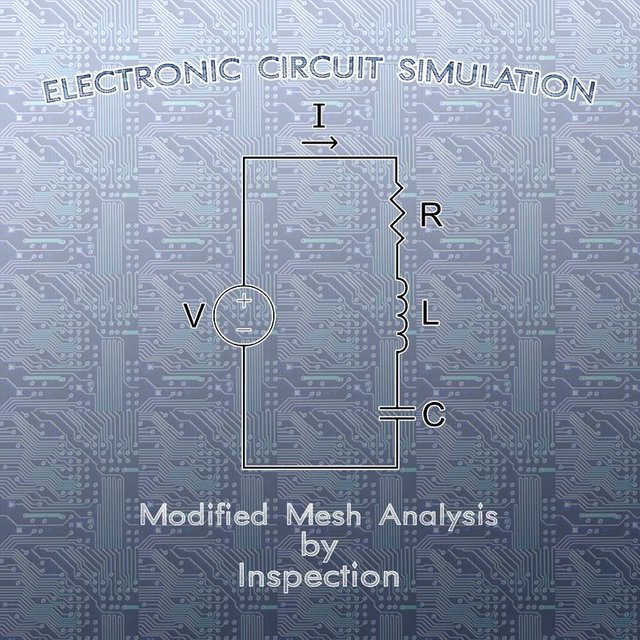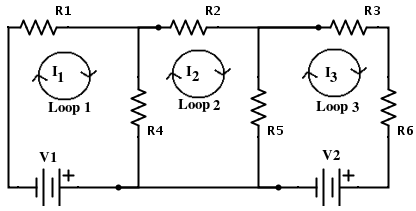Electronic Circuit Simulation - Modified Mesh Analysis by Inspection [Python]

[Custom Thumbnail]
All the Code of the series can be found at the Github repository: https://github.com/drifter1/circuitsim
Introduction
Hello it's a me again @drifter1! Today we continue with the Electric Circuit Simulation series, a tutorial series where we will be implementing a full-on electronic circuit simulator (like SPICE) studying the whole concept and mainly physics behind it! In this article we will modify the Mesh Analysis Method by Inspection, to create the linear system more easily.Requirements:
- Physics and more specifically Electromagnetism Knowledge
- Knowing how to solve Linear Systems using Linear Algebra
- Some understanding of the Programming Language Python
Difficulty:
Talking about the series in general this series can be rated:- Intermediate to Advanced
- Intermediate
Actual Tutorial Content
Mesh Analysis Method (Recap)
To recap really quick, Mesh (Current) Analysis is based on Kirchhoff's Voltage Law (KVL) and so calculating the current in the various meshes of an electronic circuit (mesh currents). The steps of this method are:- Identify the meshes of the circuit
- Assign mesh currents to each mesh
- Write the KVL equations
- Solve the linear system
- Solve for other element currents and voltages
Modifying by Inspection
In the 4th article of the series we explained the method very in-depth, solving an example using this method "by hand" and using "manual" Python Code. By the end of the article, during the Python Implementation we found out that the A-matrix contains only Resistances, whilst the b-matrix contains only Voltages, which already gave us an idea to what is coming today! But, we never really explained what exactly comes into each "cell" or coefficient of the linear system.The example circuit that we solved back then was:

To solve the circuit we basically created the following linear system:

By inspecting the resulting Linear System of this example we see that:
- The A-matrix contains only Resistances and:
- the diagonal has a positive sign, whilst the rest is negative
- each line and row is about a specific mesh
- the diagonal contains the total "self" resistance of each mesh
- the non-diagonal entries contain the mutual resistance between the meshes
- The b-matrix contains only Voltages and:
- each row talks about a specific mesh
- we put a positive sign if the current flows - → +
- we put a negative sign if the current flows + → -
So, to generalize for any circuit, let's define some "rules"...
Resistance Matrix
The general form of the Resistance matrix for n-meshes is:
Each entry gets filled based on the following rules:
- If the entry is referring to the same mesh (E.g. Ra,a), we fill it with the total "self" resistance of the corresponding mesh
- If the entry is referring to different meshes (E.g. Ra,b) we fill it with the "negative" mutual resistance of the two meshes
Voltage Matrix
The general form of the Voltage matrix for n-meshes is:
Each entry gets filled based on the following rules:
- The entry is equal to the sum of all voltage sources that occur in the corresponding mesh
- The sign of each voltage in the sum depends on "how" the current flows through the voltage source:
- positive sign if the current flows - → +
- negative sign if the current flows + → -
Linear System
So, the general form of the whole linear system is:
Manual Python Implementation
Let's now solve another example that is more complicated, by just filling in the cells of the linear system's matrices using this new modified method!Suppose that we have the following circuit:

[Image 1]
with the following resistance and voltage values:

The linear system for this circuit looks like that:

The Python code that solves this problem looks like this:
import numpy as np
'''
Electronic Circuit is
┌ R1 ┬ R2 ┬ R3 ┐
│ R4 R5 R6
└ V1 ┴────┴ V2 ┘
- + - +
with following values:
'''
R1 = 5
R2 = 10
R3 = 3
R4 = 7
R5 = 4
R6 = 1
V1 = 1
V2 = 3
'''
Mesh 1: V1-R1-R4 Loop
Mesh 2: R4-R2-R5 Loop
Mesh 3: V2-R5-R3-R6 Loop
Mesh Currents (all clockwise)
I1 for Mesh 1
I2 for Mesh 2
I3 for Mesh 3
'''
# Modified Mesh Analysis By Inspection
a = np.array([[R1 + R4, -R4, 0],[-R4, R2 + R4 + R5, -R5], [0, -R5, R3 + R5 + R6]])
b = np.array([-V1, 0 , -V2])
print("A:\n", a, "\n")
print("b:\n", b, "\n")
# Solve System
x = np.linalg.solve(a,b)
print("x:\n", x)Running this code we get the following:

So, the mesh currents are:

RESOURCES
References:
Images:
Mathematical Equations were made using quicklatex
Previous parts of the series
- Introduction
- Electromagnetism Background (part 1)
- Electromagnetism Background (part 2)
- Mesh Analysis
- Nodal Analysis
Final words | Next up on the project
And this is actually it for today's post! I hope that I was able to explain everything as much as needed!Next up on this series we will modify the other method that we covered (Nodal Analysis) by Inspection to create the Linear System somewhat automatically...
So, see ya next time!
GitHub Account:
https://github.com/drifter1
Keep on drifting! ;)
Thank you for your contribution @drifter1.
We have been analyzing your tutorial and we suggest the following points:
Thank you for your work in developing this tutorial.
Looking forward to your upcoming tutorials.
Your contribution has been evaluated according to Utopian policies and guidelines, as well as a predefined set of questions pertaining to the category.
To view those questions and the relevant answers related to your post, click here.
Need help? Chat with us on Discord.
[utopian-moderator]
Thank you for your review, @portugalcoin! Keep up the good work!
Hi @drifter1!
Your post was upvoted by @steem-ua, new Steem dApp, using UserAuthority for algorithmic post curation!
Your UA account score is currently 3.097 which ranks you at #9633 across all Steem accounts.
Your rank has improved 51 places in the last three days (old rank 9684).
In our last Algorithmic Curation Round, consisting of 195 contributions, your post is ranked at #177.
Evaluation of your UA score:
Feel free to join our @steem-ua Discord server
Hey, @drifter1!
Thanks for contributing on Utopian.
We’re already looking forward to your next contribution!
Get higher incentives and support Utopian.io!
Simply set @utopian.pay as a 5% (or higher) payout beneficiary on your contribution post (via SteemPlus or Steeditor).
Want to chat? Join us on Discord https://discord.gg/h52nFrV.
Vote for Utopian Witness!